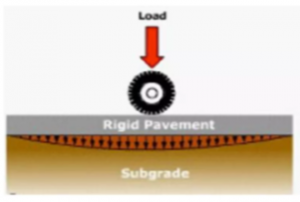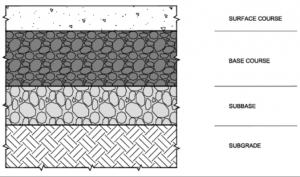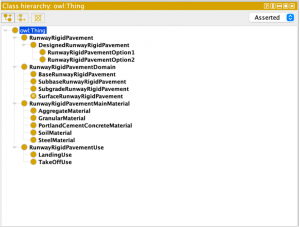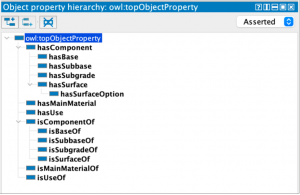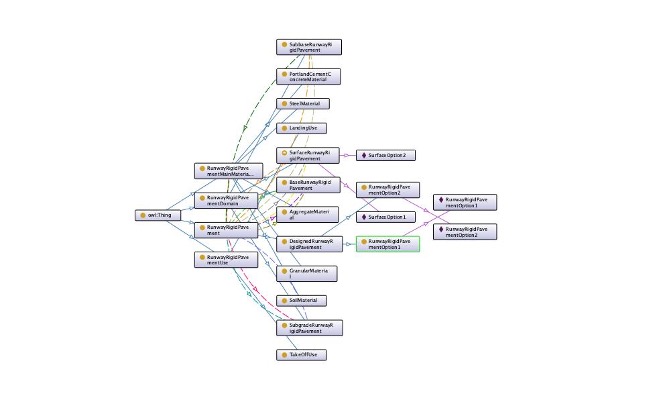Ontological Modeling
Introduction
The runway is a major component of the airport and is defined as a rectangular surface suitable for airplane landing and takeoff. The runway pavement is built to support the weight of aircraft and provide a firm, stable, and smooth surface that is free from dust and other particles all year round and in all weather conditions.
The pavement being discussed in this model is a rigid pavement, which is made of Portland cement concrete (PCC) slabs. This type of pavement is rigid and has a high modulus of elasticity, allowing it to distribute weight over a wider area of soil.
Figure 1: Load effect on a rigid pavement
An airport runway rigid pavement is a complex engineering structure with a layered structure as follows:
- Surface: The surface layer in this model is comprised of Portland cement concrete (PCC).
- Base: The base layer typically consists of aggregate materials and provides a uniform and stable support for the rigid pavement panels.
- Subbase: The subbase layer consists of granular material.
- Subgrade: The subgrade layer is made up of either natural or modified soils.
Figure 2: Typical pavement structure
Ontology of the runway rigid pavement
The ontology modeling of the airport runway rigid pavement offers a well-structured representation of the concepts and relationships involved in the design and construction of the rigid pavements. This modeling can significantly improve communication and knowledge representation in the domain, by capturing and organizing information in a structured and meaningful manner. Moreover, this structured representation supports decision-making processes by providing a clear understanding of the concepts and relationships involved, making it easier for decision makers to analyze data and arrive at informed decisions. The scope of this ontology modeling is quite broad, ranging from capturing the essential concepts and relationships involved in the domain to representing complex knowledge and decision-making processes. The intended use of this ontology modeling is for knowledge management, data analysis, decision making, and system integration, making it an indispensable tool for airport engineers, maintenance personnel, researchers, data analysts, decision makers, and developers of airport management systems.
Development of the ontology
This model categorizes the domain of runway rigid pavement into four main components: surface, base, subbase, and subgrade. Each of these categories is further divided into subclasses to provide a more detailed and comprehensive representation of the knowledge and information related to the pavement system. The complete list of classes and subclasses used in this model can be found in the figure below.
Figure 3: Class hierarchy
In accordance with the class hierarchy, the object properties have been defined as follows:
Figure 4: Object properties
The aim of this ontology is to provide a foundation of knowledge in the early stages of the pavement design process, rather than serving as a tool for designing the entire pavement. Therefore, only the surface layer is taken into consideration while defining the design options. To determine the length and width of the runways in the design options, two major airports, Munich International Airport and Frankfurt Am Main International Airport, were selected.The ontology model includes the common characteristic of the Portland cement concrete (PCC) slabs in rigid pavement, which is the joint. Joints provide a small gap between the slabs to prevent cracking during expansion on hot summer days. To prevent relative vertical displacement of adjacent panel ends and to facilitate load transfer across the joint, dowel bars are installed. These two aspects of the surface layer of the pavement were defined as data properties in the model, with the values for joint spacing and dowel specifications being dependent on the slab thickness. The following figure presents the OntoGraf created by protege:
Figure 5: OntoGraf
Parametric Modeling
Introduction
Airport runways are critical infrastructures that must be designed to accommodate a wide range of aircraft while ensuring safety and structural integrity. One of the key design challenges in the construction of airport runways is optimizing the runway’s geometric configuration to achieve the best balance between safety, structural integrity, operational efficiency, and cost efficiency. To achieve this goal, a design challenge will be chosen that requires balancing design parameters and that influences the product’s physical embodiment. Additionally, a number of high-performance criteria will be chosen to assess the performance of the runway. Finally, the system will be modeled using Dynamo, testing, and evaluating the design space to identify multiple suitable alternatives that represent well-embodied solutions. The design space will be defined by five parameters that influence the physical embodiment of the runway, namely the width and length of the runway, the thickness of the surface layer, the longitudinal slope, and the transverse slope. The parametric model will be based on high-performance criteria which are structural integrity, operational efficiency, and safety. The results of this parametric model will help identify the optimal geometric configuration of airport runway rigid pavement that meets the high-performance criteria while being cost-efficient.
Logic of the parametric model
The high-performance criteria for the airport runway rigid pavement are chosen to assess the performance of the model. The first criterion is structural integrity, which is crucial to ensure that the runway can withstand the weight and forces exerted by the aircraft during takeoff and landing, as well as the effects of weather and other environmental conditions, which were not considered in this model. The second criterion is operational efficiency, which is closely related to the length and width of the runway. A longer and wider runway allows more efficient operations, accommodating more range of aircraft types and providing more space for aircraft to maneuver during takeoff and landing. The third criterion is safety, which is important to ensure that the runway is designed and built in such a way that it minimizes the risk of accidents or incidents during aircraft operations. To ensure that the model meets these high-performance criteria, the length and width of the runway, the thickness of the surface layer, the longitudinal slope, and the transverse slope of the runway are modeled as variables. These variables are chosen as they influence the physical manifestation of the runway and affect the high-performance criteria. The selected high-performance criteria are closely related to the parameters modeled in Dynamo, with structural integrity being linked to the thickness of the surface layer, operational efficiency being linked to the length and width of the runway, and safety linked to the longitudinal slope and cross slope as well as length and width of the runway. By modeling these parameters, the performance of the runway can be evaluated against these high-performance criteria while being cost-efficient.
Figure 6: Dynamo graph
References
AC 150/5320-6F – airport pavement design and evaluation. AC 150/5320-6F (Cancelled) – Airport Pavement Design and Evaluation – Document Information. (2022, October 31). Retrieved November 27, 2022, from https://www.faa.gov/airports/resources/advisory_circulars/index.cfm/go/document.information/documentid/1030227
AC 150/5320-6G – airport pavement design and evaluation. AC 150/5320-6G – Airport Pavement Design and Evaluation – Document Information. (2022, October 31). Retrieved November 20, 2022, from https://www.faa.gov/regulations_policies/advisory_circulars/index.cfm/go/document.information/documentID/1039843
AC 150/5370-10H – standard specifications for construction of airports. AC 150/5370-10H – Standard Specifications for Construction of Airports – Document Information. (2022, October 31). Retrieved November 27, 2022, from https://www.faa.gov/airports/resources/advisory_circulars/index.cfm/go/document.current/documentnumber/150_5370-10
Defence, M. of. (2016, September 23). Airfield pavement design and evaluation guide (DMG 27). GOV.UK. Retrieved November 27, 2022, from https://www.gov.uk/government/publications/airfield-pavement-design-and-evaluation-guide-dmg-27
Yash Gang Follow Student at Shri G S Institute of Technology & Science. (n.d.). A comparative analysis on design of rigid runway pavements. Share and Discover Knowledge on SlideShare. Retrieved November 27, 2022, from https://www.slideshare.net/YashGang/a-comparative-analysis-on-design-of-rigid-runway-pavements
